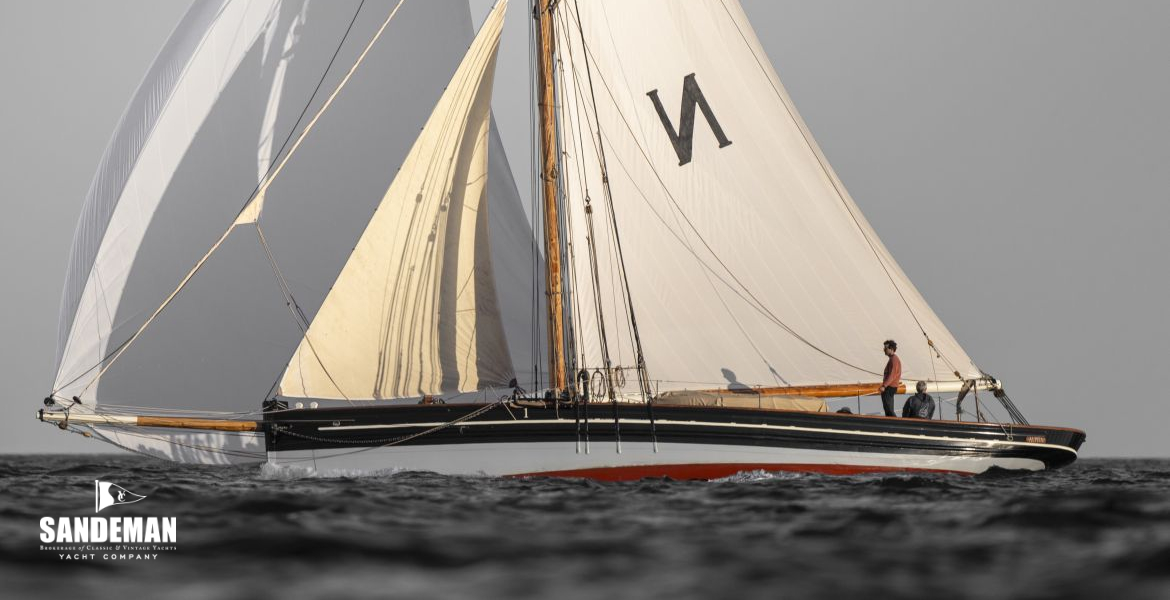
![Abeam [photo: James Robinson Taylor]](https://images.sandemanyachtcompany.co.uk/uploads/boats/142x100_479_4279704956721104ed0251.jpg)
![Aft of the beam [photo: James Robinson Taylor]](https://images.sandemanyachtcompany.co.uk/uploads/boats/142x100_479_3729650796723b3d372012.jpg)
![Windward [photo: Ewan Lebourdais/ Richard Mille]](https://images.sandemanyachtcompany.co.uk/uploads/boats/142x100_479_3020212026721177b7bf8c.jpg)

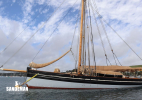
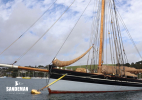
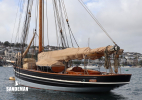
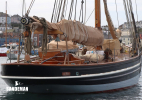
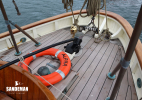
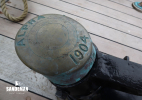
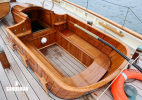
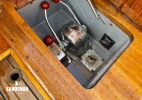

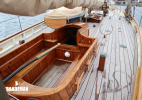
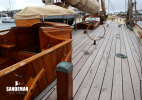
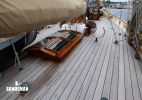
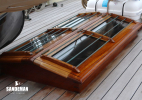
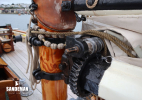
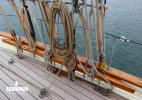
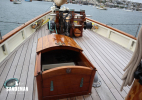
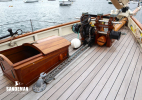

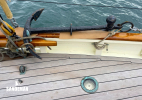
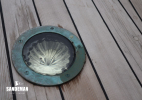
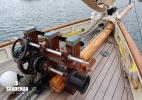
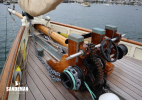
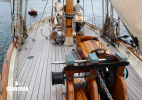
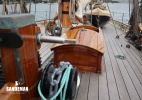
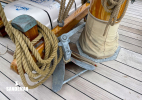
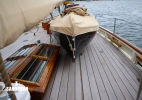
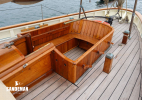

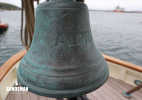
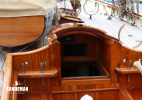
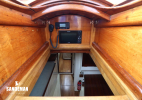
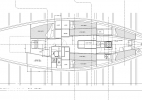
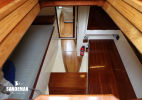
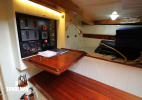
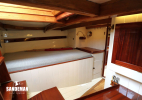
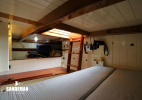
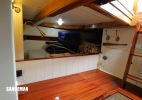
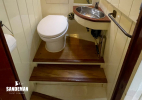
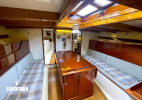
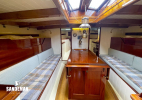
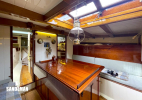
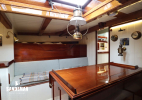
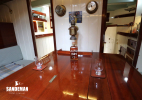
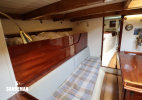
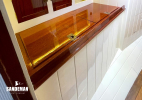
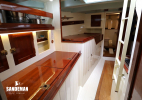
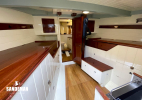
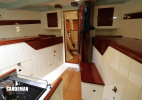
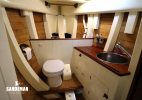
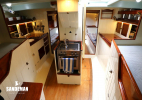
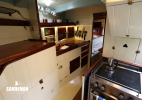
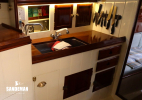
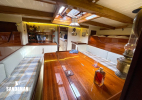
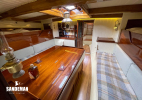
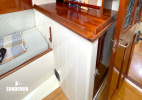
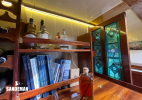
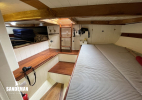
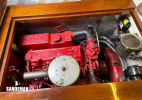
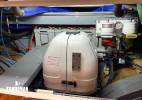
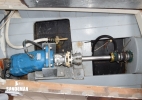
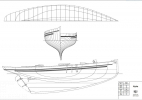
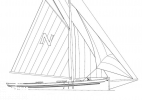
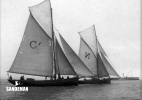
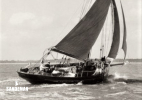
| Designer | William Stoba |
|---|---|
| Builder | Liver and Wilding, Fleetwood |
| Date | 1904 |
| Length overall | 63 ft 0 in / 19.2 m |
| Length deck | 52 ft 0 in / 15.85 m |
| Length waterline | 44 ft 4 in / 13.51 m |
|---|---|
| Beam | 14 ft 0 in / 4.27 m |
| Draft | 9 ft 0 in / 2.74 m |
| Displacement | 38 Tonnes |
| Construction | Danish oak planking on oak frame |
| Engine | Beta Marine 90 HP Diesel |
|---|---|
| Location | United Kingdom |
| Price | GBP 450,000 |
These details are provisional and may be amended
The Bristol Channel Pilot Cutter type has long been held in the highest of esteem as the perfect all round offshore sailing vessel, and ALPHA completely fits that billing. Her long and interesting life has been guaranteed to last many more years through a major restoration and, more recently, complete replanking in oak and deep refit, all in present, experienced ownership, undertaken by some of the best practitioners of their craft. Independent of superb craftsmanship, the key element restored in ALPHA is her ability from birth as an easily handled vessel under sail and power by just two experienced people, while offering the most comfortable of accommodation for long periods afloat with plenty of space for friends – or to work as a superbly appointed hands-on charter boat.
Interested in ALPHA in more detail.
It could arguably be said that ALPHA's 2007-2010 restoration at Gweek Quay, Cornwall, was by the dream team: David Walkey (master shipwright), David Cox (surveyor), the late Ed Burnett (naval architect), and Tommi Nielsen who re-masted and re-rigged her close to the original configuration, and installed the new hydraulic drives. Then, 2023-2024, in the same ownership, she was completely replanked in Danish oak and deeply refitted by a dedicated team assembled and led by Ben Hopper at Penryn, Falmouth. This included restoration of ALPHA’s original counter shape, and refurbishment of the electric systems.
Then add her present, experienced owners - who have always known what they wanted to do with ALPHA - and you have the perfect recipe for success in such projects on all fronts. In 2007, it helped greatly that they had enjoyed two full seasons of long distance Baltic sailing with ALPHA, as purchased, prior to commencing the restoration: they knew it was time for the proper job she then needed. Their experience of long periods aboard helped greatly in making her the easily handled and superbly comfortable vessel she is now - though they would be the first to say that much of that ease comes from honouring the way these vessels were once sailed by “one man and a boy”. Whilst much has necessarily and inevitably been replaced over the past 15 years or so, it is testimony to her original builder’s skills, and the quality of materials then available, that the wood keel and keelson could be retained, and honoured by reconstruction using the traditional methods that had stood her in good stead.
The greatest change to ALPHA's original construction may be the successful use of glued and screwed solid wood, not plywood, bulkheads to stiffen the hull without detracting from her appearance and feeling of authenticity, and the non-traditional but unseen use of twin screw propulsion under power to make her superbly manoeuvrable in marinas and harbours.
ALPHA's story offers a fascinating glimpse into a period in the late 19th and early 20th centuries when the design principles of handy and fast commercial sailing vessels and private pleasure yachts were overlapping and feeding between disciplines. Commercial designers / builders were learning from the rapidly developing understanding of what makes a sailing yacht fast and weatherly, and as the sailing pilot and fishing craft improved, their desirability as a model for trusty, short-handed cruising yachts became legend - and remains so.
ALPHA's designer, William Stoba of Fleetwood, Lancashire, had never built a pilot cutter for the notorious waters of the Bristol Channel before being commissioned by her first owner, William Prosser of Newport, but Stoba had gained an enviable reputation for the design of his fast Morecambe Bay Prawners and Lancashire Nobbies - and some fine yachts. Prosser was prepared to take a risk on Stoba in order to steal a march on his competitors: to be first to the ships requiring pilotage, time and again.
So ALPHA, with her typically “Prawner” cutaway and rounded forefoot profile, is a little different from Bristol Channel Pilot Cutters by other designer-builders, and that feature is credited for her famous turn of speed, particularly in light winds. That she was successful is proven by her retention by Prosser for 20 years.
Her life as a pleasure craft began as the renamed BLACK BESS in 1924 under the ownership of Royal Cruising Club flag officer Sir Sidney Rowlatt. According to John Buchan, author of “The 39 Steps”, Rowlatt had a “boyish zest for sailing… in the gusty channel”. It is known from the log of the Bristol Channel Pilot Cutter CARIAD that in August 1926 she met BLACK BESS (ex ALPHA) off Dodman Point; and to quote from the log, BLACK BESS then “sailed away from CARIAD”.
A succession of owners from the 1930s, when she regained her original name, to the near present succumbed to her charm and ability - and her demands for just deserts - to ensure her survival into the new world of love and care for wooden boats that arrived in the 1980s.
Her present, very experienced traditional boat owners were looking specifically for a Bristol Channel Pilot Cutter at a time when ALPHA was luckily available. After her major restorations they have honoured her past life, more often than not by sailing her easily short-handed and successfully racing her fully crewed - just as she was in her earlier working life.
It is true to say though that her superb present day accommodation, whilst honouring the layout and spirit of her working days, offers rather a lot more comfort than her pilots and crew would have enjoyed in times past.
As sail gave way to power in the between-the-wars pilotage world, it's no wonder that vessels like ALPHA became sought after as superb cruising yachts: in their working life they had to be fast and manoeuvrable, and comfortable hoved-to when spending long periods at sea on the lookout for paying work.
©2025 Iain McAllister/ Sandeman Yacht Company Ltd.
- Danish oak carvel planking (2024) on Danish oak frames
- Stem and sternpost of ekki. Fore and aft dimension of stem increased from original
- Steel external shoe to keel
- Concrete and lead shot internal ballast
- Douglas fir deck straight laid on oak deck beams, nibbed to covering boards
- Original teak cockpit coaming and companionway hatch
- All other deck furniture teak
- Internal bulkheads of glued / screwed mahogany and pine designed for hull stiffness
AFT
- Elliptical raked counter
- Painted bulwarks with scupper gap and varnished iroko capping rail
- Galvanised Blake of Gosport bronze and nylon buffered mainsheet horse believed original
- Mainsheet horse is bolted through counter with nuts exposed
- 2 x Galvanised mainsheet cheek block pad eyes
- 2 x Galvanised boom restraint pad eyes
- Bronze capped rudder stock with name and year engraved believed original
- Rudder stock tube head clamped to aft face of projecting sternpost
- Original galvanised iron tiller with bronze handle
- Douglas fir laid lazarette hatch; bronze mushroom vent
- Boom gallows (2020)
- Original ship's bell
- Yellow metal through-deck Diesel heater exhaust pipe up stand and bend
- Bronze Panama fairleads at quarter bulkheads
- Belaying cleats each side fastened to bulwark stanchions
- 4 x Bronze capped oak mooring / belaying Samson posts
COCKPIT
- Self-draining
- Original teak lining-board high cockpit coamings raked as breakwater aft
- Teak sheet cleats outboard of side coamings
- Tanks vents at outside of aft coaming
- Stainless steel spray hood fittings at coamings and companionway hatch
- Deck diesel and water filler fittings outboard of cockpit coaming corners
- Deep self-draining cockpit with iroko bench each side and aft
- Four cockpit drains
- Custom cockpit cushions
- Sockets under aft bench for shore power
- Pair of belaying pins each side of companionway for aft halyard leads via grommets
- Silva steering compass with light at forward cockpit-well bulkhead
- Teleflex engine controls in bench locker forward starboard
COMPANIONWAY HOUSE
- Teak companionway house; believed original
- Raymarine display and VHF radio
- Newer teak sliding hatch with original bronze hasp
SIDE AND MID DECKS
- Galvanised cap rail mounted guard rail stanchions
- Guardrail tapers to cap rail level pad eyes fore and aft
- Midships belaying cleat each side fastened to bulwark stanchions
- Deck prisms to starboard over aft berth and aft head
- Dinghy stowage chocks to port between companionway and skylight
- 10 ft glued clinker plywood dinghy, designed and built by present owner
- 3 x Bronze mushroom vents
- Life raft stowage aft of mast
- Stowage hoops to starboard for topsails and yards
- Large teak butterfly skylight over saloon with bronze glass protection bars
- Covered screw-in bronze pad eye positions at side decks
- Fixed position bullseye headsail sheet leads at side decks
- Traditional “pilot's” boarding ladder
- Bulwark mounted bronze belaying pins rail each side in way of shrouds
- Deck prisms to galley / fore cabin
- 2 x Galvanised through-deck fastened eyebolt supports to belaying pin rails
- Substantial king posts / rails aft of mast with sheaves to lead halyards aft
- Acrylic mast boot
FOREDECK
- Raised teak sliding fore booby hatch offset to port
- Fixed washboard; original bronze hasp
- Galvanised anchor chain pipe forward of mast with chain leading forward on copper track
- Substantial oak/ teak bowsprit bits inc. Spencer Carter manual anchor windlass (2016)
- Simpson-Lawrence bronze mushroom vent at port foredeck
- Deck wash hose fitting
- 2 x Bulwark Panama fairleads forward
- Chain pipe through port apron
- Carved wooden mooring line fairleads atop forward capping rail either side of stem
- Mooring roller to port of stem side
- 2 x Bullseye bowsprit traveller fairleads to starboard of stem side
- Galvanised bobstay fitting
GROUND TACKLE
- 80 kg Fisherman bower anchor
- CQR kedge anchor stowed to starboard of belaying rails
- Galvanised chain
SUMMARY
- Accommodation for 8 / 9 in three cabins
- T&G V-grooved mahogany/ pine lining elevations contribute to structural stiffness
- The mahogany joinery all taken from a single tree
- Elevations white painted throughout
- Varnished mahogany tops, doors and detailing
- Varnished carved “clover” ventilated panel between top hull ceiling plank and beam shelf
- Locker catches to an Olin J Stephens design
- All lights LED
- Most lockers have lights
- LED strip lighting red/white throughout the boat
- Selected interior lights are dual red / white
AFT CABIN PORT
- Companionway via two ladders to aft cabin
- Generator area under cockpit, in step box and small shelves in aft bulkhead
- Double berth to port
- Mid lee cloth split converts port berth to smaller passage making berth
- Sideboard between berth and forward cabin bulkhead with fiddled top
- Locker stowage at bunk foot and head lockers, and under sideboard
- Bulkhead mounted clock and reading lamp
- Deckhead light
AFT CABIN STARBOARD
- Fold-down chart table to starboard
- reveals bulkhead mounted electrical and engine panels
- Chart reading/ bunk reading light
- Pencil and divider stowage under
- Low level bench to starboard
- Quarter berth bunk outboard; light prism in deckhead
- Open aft end of quarter berth to stowage; diesel tank; filters
- Locker in bunk bulkhead forward with inverter /converter and other electric devices
- Door starboard forward to en-suite WC compartment
WC COMPARTMENT TO STARBOARD
- Tecma 12 V WC; corner sink with waste pump
- Deck head light and deck prism
- Stowage in outboard bulkhead including hanging locker beside water tank
- Bevelled mirror
- Toilet roll holder
- Towel rail
- From aft cabin offset to port leaded glass glazed panelled mahogany door forward
SALOON
- Sideboard to port with fiddled top and stowage under
- Port settee with pilot berth outboard; slot-in leeboards; stowage under settee
- Stowage locker at aft end of pilot berth
- Reading lights fore and aft
- Settee cushions and back cushions of light coloured fabric
- Removing back cushions offers wider bunk and access to under pilot berth lockers
- Large folding leaves saloon table; engine under accessed from above by hatch
- Further dismantling of table accesses other parts of engine
- Swinging oil lamp above table
- Large opening butterfly skylight above
- Gimballed oil lamp at forward bulkhead with original clock and Hughes barometer
- Starboard settee with pilot berth outboard; slot-in leeboards; stowage under settee
- Stowage locker at aft end of pilot berth
- Reading lights fore and aft
- Deck head light
- Settee cushions and back cushions of light coloured fabric
- Large sideboard aft with bottle and book stowage shelves above and glass stowage under
- Barograph
- Doors to port and starboard of central forward bulkhead leading to galley / fore cabin
GALLEY/ FORE CABIN
- Port door from saloon leads to semi corridor by mast
- Lift-lids refrigerator / freezer box to port; stowage lockers and pan stowage outboard
- Spice rack
- Removable aluminium fore hatch ladder
- Prism light in deck head over
- Port fore cabin berth forward of cool box with foldaway top surface
- Access to refrigeration unit under
- Reading light aft; locker space forward with door forward
- Netting foldaway shelf at beam shelf
- Door to fo'c'sle in forward bulkhead
- Deck head light
- LED red/ white strip lighting
FOREPEAK
- Tecma 12 V toilet on plinth
- Stainless steel inset sink unit to starboard
- Pull-out shower head type tap (no shower tray)
- Stowage locker under
- Toilet roll holder and towel rail
- Part bulkhead forward of toilet creates stowage / hanging space
- Deck wash pump and piping to port; toilet pump and vacuum valves to starboard
- Exit to Forecabin / Galley
GALLEY/ FORECABIN STARBOARD
- Starboard fore cabin berth with step up containing a battery; foldaway top surface
- Reading light aft; locker space with door forward
- Netting foldaway shelf at beam shelf
- Access to calorifier tank under bunk
- Forward facing cooker amidships; panelled-in mast/ chain locker access
- GN Espace Levante 2 Induction Cooker; 2 x hob, grill, oven
- Passage to starboard of mast
- Galley 2 x basin sink unit with stowage under and over
- Plate rack over sink unit
- Deck prism
- Spotlight
- Pressure fresh water and manual salt water taps
- Quooker fresh water heated / cooled source
- Doorway aft of starboard mast passage leads to starboard side of saloon
- Passing aft through saloon and aft cabin exit to cockpit
RIG
Spars
- Douglas fir mast and all spars
- Mast by Tommi Nielsen 2015 with shake-avoiding longitudinal splined split
- Galvanised steel spreaders with deck lights
- Radome at port spreader
- Boom (age unknown)
- Substantial galvanised roller boom reefing “Appledore-gear”; believed original
- Mainsheet shock buffer; believed original
- Semi retracting bowsprit restored to original length 2015
- Original leathered gaff saddle with parrell balls
- Combined parrell balls and lacing for luff – no hoops
- Hollow jackyard topsail spars
- Hollow spinnaker boom Standing and running rigging
- Hand-finished 7 x 19 galvanised steel standing rigging by Tommi Nielsen 2015
- Rigging only parcelled at splices
Shrouds to bottlescrews with galvanised pin rail above
- Partial ratlines
- External galvanised chain plates
- Aftermost shroud aft enough not to require running backstays
- Topmast Dyneema “swifter” running backstays set when ballooner in use
- Tan polypropylene running rigging
SAILS
- Mainsail (2024)
- Staysail (2014)
- Working topsail (2002)
- 2 x Racing jackyard topsails (2015 & 2016)
- 4 x Jibs (1998, 2014, 2016)
- 2 x Jib top
- 2 x Ballooners (2013 & 2016)
CANVASWORK
By James Lawrence and Owen Sails
- Boom cover
- Boom tent in two parts
- Spray hood
- Forehatch cover
- Skylight cover
- Cockpit cover
- Complete boat cover (winter tent)
SUMMARY
- Systems installed 2011; updated 2024
- Designed to keep weight in middle of the boat; batteries near centre
- Engine immediately aft of and chain locker immediately forward of mast
MECHANICAL
- Beta Marine 90 HP 4 cylinder naturally aspirated diesel engine
- Forced draftt ventilation for engine box
- Split exhaust: wet exiting by forward stbd chain plate; dry part exiting at counter
- Samhydraulik hydraulic drive system
- Vetus stern gland seals
- 2 x Darglow feathering propellers
- Cruising speed 6.5 Knots @ 1700 rpm – consumption 7 L per hour
- Max speed 8 Knots @ 2200 rpm
MECHANICAL/ ELECTRICAL
- Fisher Panda 5000i Neo 5 kVA generator (2024)
- 230 V High output alternator 130 A (2024)
ELECTRICAL
- 4 x 225Ah 12 V AGM batteries (2024)
- 1 x engine start battery
- Mastervolt upgraded 150 A charger/ inverter/ isolating transformer
- Vertical axis wind generator at upper mast
- Deck socket for searchlight
- 2 x 12 V Sockets in accommodation
- 3 x UK type 13 A 230 V sockets
- 8 x USB sockets
TANKAGE AND ASSOCIATED
Water
- Isotherm engine calorifier domestic hot water pressure system with 230 V element
- 1,500 litres fresh water in 3 x stainless steel tanks
- 2 x of the water tanks supply the pressure water system
- Aft head sink independent of pressure water system with own tank and manual tap
Fuel
- 2 x 200 L Stainless steel diesel tanks under cockpit
OTHER
- Isotherm 12 V seawater-cooled refrigeration / freezer system
- Eberspächer Airtronic D5 diesel ducted blown air heating
NAVIGATION
- Raymarine 'hybridtouch' display plotter, radar, fish finder, AIS
- Believed original barograph, barometer, and Hughes (pre Kelvin Hughes) clock
COMMUNICATIONS
- Icom DSC VHF IC-M323 at companionway
- Previously coded to MCA Cat 2
- 2 x ACR EPIRBs; Pathfinder and Mini B300
- 2 x Ring lifebelts
- Life Jackets, life lines
- Fire suppression system
- 4 x Fire extinguishers
- Smoke detectors
- 2 x Electric bilge pumps; one with float switch
- 1 x Manual bilge pump in cockpit
- 12-Person life raft
- Ship's bell; original
- Lopolight running lights disguised in forward bulwark
- Lopolight stern light at counter
- Lopolight masthead tricolour and all-round white, and mast forward steaming
Fenders
- Mooring
warps
Contact us to discuss ALPHA in more detail.
These particulars have been prepared from information provided by the vendors and are intended as a general guide. The purchaser should confirm details of concern to them by survey or engineers inspection. The purchaser should also ensure that the purchase contract properly reflects their concerns and specifies details on which they wish to rely.